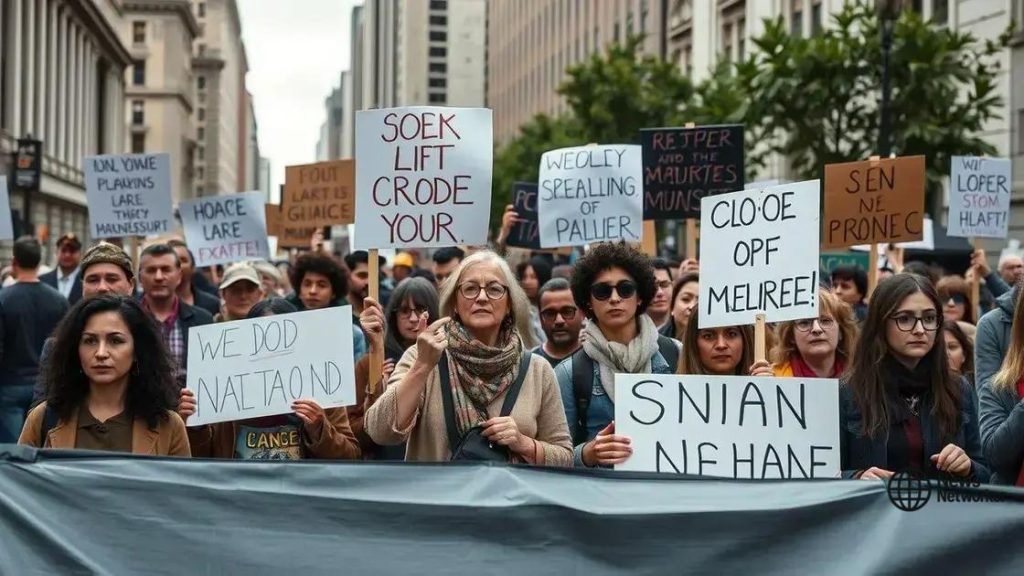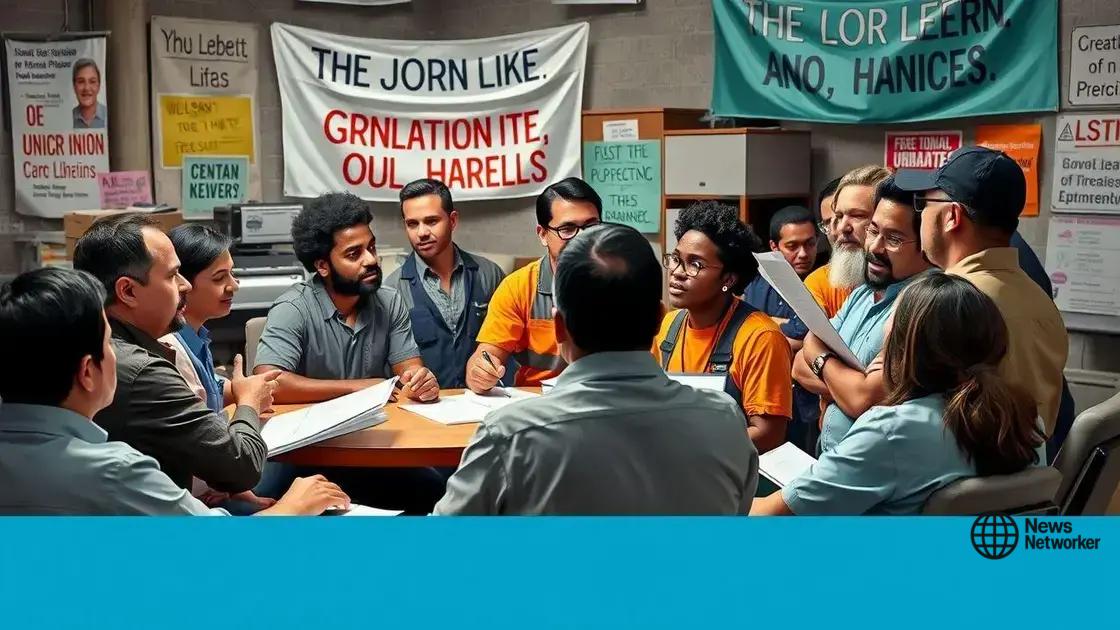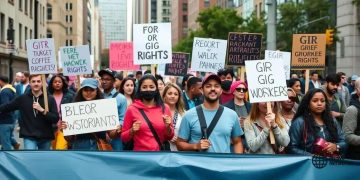Mass protests and union organizing: what you need to know

Mass protests and union organizing significantly impact labor rights by raising awareness, influencing public policy, and empowering workers to demand better wages and conditions through collective action.
Mass protests and union organizing have become critical components of social change today. But have you ever wondered how they truly influence our workplaces and communities? Let’s explore their significance.
Understanding the rise of mass protests
The rise of mass protests has become a common sight in recent years, capturing the attention of people around the world. Understanding this trend requires us to look at the social, economic, and political factors that contribute to these movements.
One major factor is the growing inequality seen in many countries. As the gap between the rich and the poor widens, citizens often feel frustrated and powerless. This frustration can lead to large-scale protests as people demand change. Furthermore, social media has played a crucial role in organizing these movements, allowing individuals to share information and rally support quickly.
Key Factors Behind Mass Protests
Several key factors drive the rise of mass protests:
- The influence of social media in mobilizing supporters.
- Government policies that citizens view as unjust.
- Economic struggles that affect everyday lives.
- A desire for greater social justice and equality.
Another important aspect is the role of culture and identity. Many protests are fueled by specific cultural issues that resonate broadly, bringing diverse groups together under a common cause. When people feel disconnected from their government, they often turn to protests as a way to make their voices heard and advocate for their rights.
It’s also noteworthy that the response of authorities can either escalate or de-escalate tensions. In some cases, swift action by governments can quell dissent, while in others, forceful measures can aggravate the situation further. The choice of response often shapes the narratives surrounding protests.
The Global Impact of Recent Protests
Globally, we’ve seen protests addressing a variety of issues, including climate change, racial inequality, and women’s rights. These movements illustrate how interconnected our challenges are today. By coming together, people can amplify their messages and push for systemic change that benefits society as a whole.
As we explore the reasons behind the rise of mass protests, it’s clear that they are a powerful tool for societal change. They highlight the voices of the marginalized and call for a more equitable world. Awareness of these issues is crucial for fostering understanding and support among all individuals.
The role of unions in modern society
In today’s world, unions play a critical role in advocating for workers’ rights and improving working conditions. Understanding their significance helps us appreciate the impact they have on modern society.
Unions fight for fair wages and benefits, ensuring that their members are compensated adequately for their work. This advocacy is crucial, especially in industries where workers may feel undervalued. By organizing collectively, workers can negotiate better terms than they could alone.
Key Functions of Unions
Unions serve several important functions:
- Advocating for workers’ rights in negotiations with employers.
- Providing legal representation and support in disputes.
- Promoting safe working conditions and effective health benefits.
- Facilitating training and education programs for workforce development.
Beyond just negotiations, unions contributed to shaping labor laws and policies that benefit all workers. Their influence can lead to better regulations on workplace safety, minimum wage standards, and anti-discrimination measures. Many of the rights we enjoy today originated from long-fought union battles.
The presence of a union can also boost morale within a workplace. When employees feel they have representation, they’re often more engaged and productive. This engagement fosters a positive working environment, as workers are more likely to voice concerns and contribute to improvements within their companies.
Challenges Faced by Unions Today
Despite their successes, modern unions face various challenges. In many countries, there has been a decline in union membership, making it tougher to achieve collective bargaining agreements. Additionally, some political environments are less conducive to union activities, leading to tensions between labor groups and lawmakers.
As society continues to evolve, unions are adapting to new scenarios. Issues like gig economy jobs and remote work raise questions about how unions can best support workers. This adaptability is vital for ensuring that unions remain relevant and effective in today’s fast-paced labor market.
Case studies of successful union organizing

Case studies of successful union organizing provide valuable insights into effective strategies and actions that have led to positive outcomes for workers. These examples showcase how dedicated efforts can bring about change and improve working conditions significantly.
One prominent example is the fight for organizing workers in the fast-food industry. Fast food workers across the U.S. successfully organized strikes demanding higher wages and better working conditions. This movement helped raise awareness about the value of labor and led to many cities implementing a $15 minimum wage. This case highlighted how collective bargaining can influence policy with strong public support.
Key Examples of Successful Organizing
Some key case studies include:
- The United Farm Workers (UFW), which organized agricultural workers to improve labor rights, leading to historic contracts that enhanced wages and working conditions.
- The Teachers’ Unions that have grown in strength, successfully advocating for better pay and resources in public schools.
- The National Nurses United, which effectively organized nurses to address staffing ratios and patient care standards, resulting in improved healthcare environments.
These examples demonstrate that successful organizing often involves grassroots strategies and strategic communication. Workers connect with their communities, spreading awareness and building support for their cause. Union leaders also focus on training members in negotiation tactics, ensuring they are prepared for discussions with employers.
The impact of these organizing efforts extends beyond individual workplaces. Successful cases of union organizing often encourage other workers in different industries to take action. This ripple effect can lead to an overall strengthening of labor movements. As workers see the successes of their peers, they may find the courage to band together and advocate for their rights, knowing change is possible.
Impacts of protests on labor rights
The impacts of protests on labor rights can be profound and transformative. Through collective action, workers have historically gained better working conditions, fair wages, and improved job security. Protests serve as a powerful tool for raising awareness and mobilizing public support around labor issues.
One of the most significant impacts is the change in public perception regarding labor rights. When protests occur, they often draw media attention, shining a light on the struggles workers face. This increased visibility helps garner community support, leading to broader advocacy for labor reforms.
Key Impacts of Protests
Some key impacts of protests on labor rights include:
- Increased awareness of worker exploitation in various industries.
- Political pressure on lawmakers to enact labor-friendly legislation.
- Enhancement of community relationships and solidarity among workers.
- Inspiration for new unions and labor movements.
Moreover, protests can lead to concrete changes in policies. For example, many labor laws that protect workers’ rights today were established after significant public demonstrations. These protests can lead to reforms such as minimum wage increases, overtime pay regulations, and safer working conditions.
Another important aspect is the influence of protests on negotiations between employers and employees. Workers who engage in protest typically have stronger bargaining power. With public backing and heightened media attention, employers may feel pressured to meet demands to avoid negative publicity.
Long-term Effects on Labor Movements
Over time, the cumulative effects of these protests can reshape the landscape of labor rights entirely. Increased union membership often follows successful protests, empowering more workers to stand up for their rights. When labor movements grow stronger, they become more effective at negotiating better terms for all workers, not just those in organized industries.
Ultimately, the impacts of protests on labor rights underscore the importance of collective action. They demonstrate how ordinary workers can come together to challenge injustices and advocate for a fairer workplace. Through these efforts, labor rights continue to evolve, reflecting the needs and aspirations of the workforce.
Future trends in union activism
The future of union activism is poised to evolve rapidly, reflecting changes in the workforce landscape and societal needs. As new generations of workers enter the job market, they bring fresh perspectives and demands that will shape the nature of union activities.
One emerging trend is the growing demand for flexible work arrangements. As remote and hybrid work models become commonplace, unions are starting to address these changes. Workers are seeking better negotiations for their rights with respect to remote work, flexible hours, and work-life balance.
Key Future Trends
Some key trends in union activism include:
- Increased focus on diversity and inclusion within unions.
- Utilization of digital tools and social media for organizing efforts.
- Emphasis on environmental and social issues affecting workers.
- Expansion of union reach into gig and freelance workers’ rights.
Moreover, as society becomes more interconnected, union activism is likely to adopt a broader social justice framework. This means advocating not only for workers’ rights but also for environmental sustainability and fair treatment of all marginalized groups. Unions are beginning to recognize the importance of these intersections, which can help them build stronger coalitions across various social movements.
Additionally, technology is transforming the way unions operate. Through apps and online platforms, unions are enhancing communication and mobilizing members more efficiently. This digital shift can help organize workers quickly, allowing for rapid responses to workplace issues.
Challenges Ahead
Nonetheless, the future of union activism also faces challenges. Resistance from employers and political opponents can hinder progress. Additionally, maintaining member engagement will be essential for unions to remain relevant. As workers evolve, so must the strategies unions use to address their needs.
The upcoming years will be crucial as unions adapt to these changing dynamics. By embracing new trends and technologies, unions can remain relevant and continue to advocate effectively for worker rights in an ever-changing economic landscape.
FAQ – Frequently Asked Questions about the Future of Union Activism
What trends are shaping the future of union activism?
Current trends include a focus on technology for organizing, increased emphasis on social justice issues, and greater attention to the rights of gig and freelance workers.
How will technology impact union organizing?
Technology will enable unions to communicate more efficiently, mobilize members quickly, and utilize digital tools for organizing efforts.
What role do protests play in labor rights?
Protests raise awareness about worker issues and create political pressure for labor-friendly policies, making them a vital tool for achieving workers’ rights.
Why is diversity important in union activism?
Diversity in unions ensures that the voices of all workers are represented and can strengthen the movement by encompassing a wide range of perspectives and needs.





